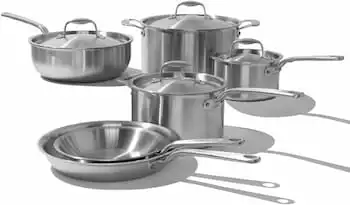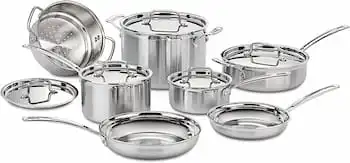Hard Anodized Vs Stainless Steel Cookware – Which One to Buy?
The choice of cookware can significantly impact your cooking experience and the flavors that grace your plate. Two popular contenders in the realm of kitchen essentials are hard anodized and stainless steel cookware. These materials have distinct qualities that cater to various cooking styles, preferences, and even dietary considerations.
In today’s world, we have a lot of cookware materials available in the market. So, it becomes a very tough job to choose the right one for our daily use. With time, new designs and materials are introduced in the market, making it more confusing to choose the right one.
In this blog post, we will embark on a culinary journey to unravel the characteristics and benefits of hard anodized and stainless steel cookware.
By understanding their unique attributes, you’ll be equipped with the knowledge to make an informed decision and enhance your culinary prowess.
By the end of this article, you’ll have the confidence to choose the perfect cookware that aligns with your cooking style, ensuring delicious results every time.
Hard Anodized Vs Stainless Steel Cookware: Comparison Table


| Hard Anodized | Stainless Steel | |
| Safety | It is also safe to use as the coating covers Aluminum from any exposure to food. But if used for a long time, the safety decreases. | It is one of the safest materials for cookware. Chemical penetration is hard. |
| Heat-Conductivity | It is a good conductor of heat. The food is cooked evenly. | It is not a good conductor of heat, and hence the cookware gives rise to hot spots. This can be solved by binding stainless steel with copper. |
| Nonstick coating | It comes with a nonstick coating. Cooking in nonstick helps to save oil and cook healthy food. Food doesn’t stick, and hence less effort is required to clean. | Generally, this doesn’t have a nonstick coating. Hence the oil required is more. Also, food sticks in such cookware and more effort is required to clean. |
| Durability | It is strong and durable and also rust-free, and corrosion-resistant. But the coating may wear down with time. | The material is strong and durable. It is also rust-free and corrosion-resistant. |
| Maintenance | The nonstick coating makes it easy to clean. It can be clean with a sponge, cleaner warm water, and dish wash. It is not dishwasher-friendly. | It can be cleaned with a dishwasher. It requires more effort to clean. While handwashing, it requires a metal scrubber to clean the sticky food. |
| Induction Friendliness | Not Induction Safe | Induction Safe |
| Price | The price depends on the hard anodized cookware line. | The price depends on quality. It varies from very high to very low, depending on the quality of the metal. |
Hard Anodized Cookware

Aluminum, as we all know, is one of the lightweight materials. It is used for making many things, including cookware. It is also next to copper in heat conductivity.
But it is quite expensive due to its availability on earth. Also, it reacts with the food, especially acidic dishes.
So to avoid these, many manufacturers come with an innovative form of Aluminum. Hard Anodized Aluminum is made through an electrolytic process where oxides are gathered on the surface of the Aluminum.
An electrolytic process does it. The Aluminum is immersed in a chemical (sulfuric acid). After that, a low electric current is applied to it. This produces an oxide that gathers on the surface of Aluminum. Once it is culled, the Aluminum becomes harder and stronger than before. Thus the result produced is Hard Anodized Aluminum.
After the process, the Aluminum cookware is called Hard Anodized Cookware. In simple words, Aluminum with an oxide coating on its surface can be termed as Hard Anodized Aluminum.
Hard-Anodized aluminum is used for making a variety of products, especially cookware. The reason behind choosing this material is as follows:
- It is harder than natural Aluminum and hence more durable.
- It has a smooth surface.
- It doesn’t react with food which is the tendency of natural Aluminum.
- It is a good conductor of heat. And a coating of oxide makes it corrosion resistant.
Some of the best brands which use this material are Calphalon, All-Clad, Circulon Symmetry,, and Rachael Ray.
If you are looking for cost-effective and durable cookware, then this one’s for you. Also, because of its smooth surface, there are lesser chances of food getting stuck.
Additionally, it is easy to clean and is scratch-resistant. So it is best suited for liquid foods as some food may get stuck and will be hard to clean.
Pros of Hard Anodized Cookware
Stainless Steel Cookware

Stainless Steel is a corrosion-resistant material. It is an alloy made of various metals. The main metals present are chromium (10.5%), carbon (less than 1.2%), and iron.
Sometimes other metals like nickel, titanium are also added to improve its efficiency. Stainless steel is used for making cookware because it has various advantages.
Also, it is rust-free and corrosion-resistant. Also, it is a versatile material. It doesn’t bend or crack easily.
Some of the best brands include Calphalon and All-Clad. Stainless steel cookware is best suited for making sauces and acidic food. It doesn’t react with acidic ingredients like tomato sauce or meat dipped in wine.
Additionally, its versatility makes it all-purpose cookware. But, the stainless steel cookware is not scratch-resistant. Also, because of its elasticity, it is available in different attractive designs.
Pros of Stainless Steel Cookware
Hard Anodized Vs Stainless Steel Cookware: Differences
1. Material & Construction
Stainless steel cookware is crafted from a combination of metals, typically featuring an aluminum or copper core sandwiched between layers of stainless steel. This construction ensures even heat distribution and durability, making it resistant to staining and rust.
On the other hand, hard-anodized cookware is made from aluminum that has undergone an electrochemical process, which creates a non-reactive and incredibly durable surface.
2. Heat-Conductivity
Hard-Anodized aluminum is a good conductor of heat. The food is cooked evenly. So it takes much less time to cook food.
Stainless steel itself is not a good conductor of heat, and hence the cookware gives rise to hot spots. That’s why stainless steel is being cladded with copper or aluminum to heat evenly.
3. Nonstick Coating
The Hard-Anodized Aluminum comes with a nonstick coating. Cooking in nonstick helps to save oil and cook healthy food. Food doesn’t stick, and hence less effort is required to clean.
While the cookware is made of stainless steel generally, it doesn’t have a nonstick coating. Hence the oil required is more. Also, food sticks in such cookware, and more effort is required to clean.
4. Durability
The cookware made of Hard Anodized Aluminum is strong and durable and rust-free, and corrosion-resistant. But the coating may wear down with time.
While stainless steel cookware is strong and durable, it is also rust-free and corrosion-resistant.
4. Induction Compatibility
Unfortunately Hard Anodized is not induction safe because it isn’t made of ferromagnetic material which is bad news for the induction owner.
On the other hand stainless steel can be used on induction stove without any hurdle so you can buy it without any second thought.
5. Maintenance
The nonstick coating in hard anodized cookware makes it easy to clean. It can be clean with a sponge, cleaner warm water, and dish wash. It is not dishwasher-friendly.
The stainless steel cookware can be cleaned with a dishwasher. It requires more effort to clean. While handwashing, it requires a metal scrubber to clean the sticky food
6. Price
The price of Hard Anodized Aluminum cookware depends on the quality and brand that offers cookware.
While stainless steel cookware’s price depends on the how many layers included, if its 3-ply is less expensive than 5-ply.
1. Safety
Stainless steel is one of the safest materials for cookware. Chemical penetration is hard. The Hard Anodized is also safe to use as the coating covers Aluminum from any exposure to food. But if used for a long time, the safety decreases.
Hard Anodized Vs Stainless Steel: Which Cookware Should You Choose?
Both the cookware has their advantages and disadvantages. If you like to cook in nonstick cookware, then Hard-Anodized cookware is the best choice for you. Also, it is cost-effective and not so expensive. In the same way, nonstick cookware is easy to use and clean.
On the other hand, stainless steel cookware is very common because of its durability and appearance. It is also quite expensive compared to the Hard-Anodized. So, in my opinion, if you want to go for nonstick cookware, you should go for Hard-Anodized Aluminum. If you want elegant-looking, expensive cookware, then you should choose stainless steel.

